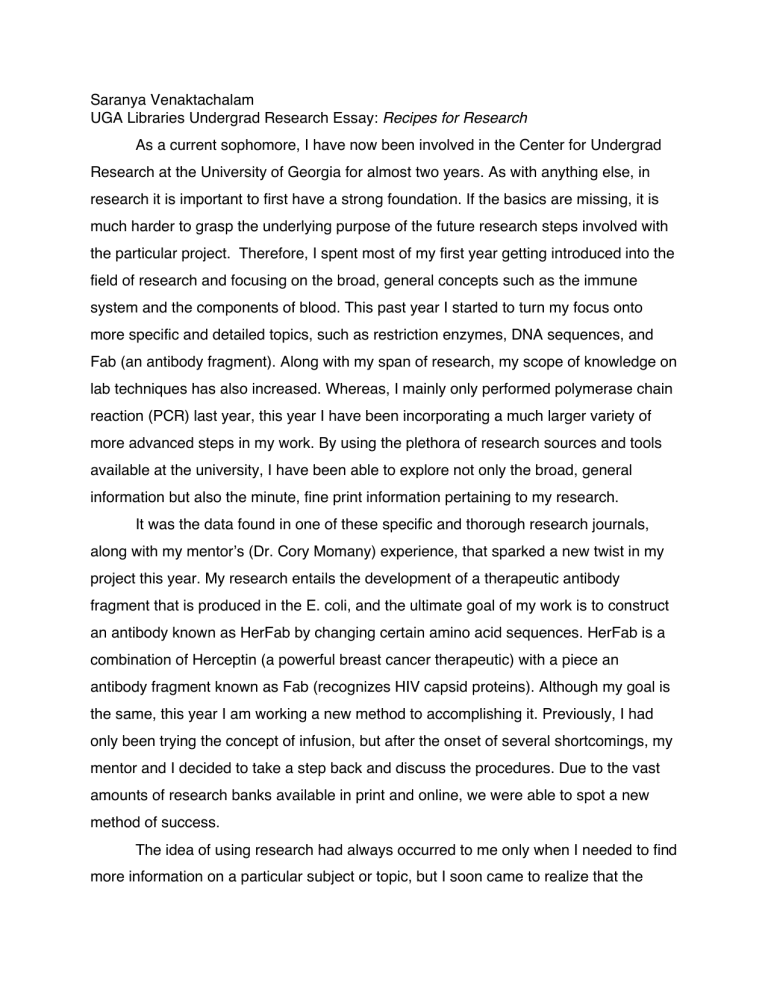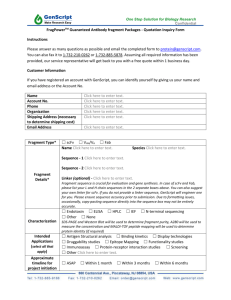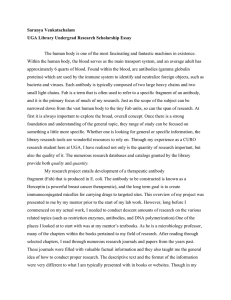Saranya Venaktachalam Recipes for Research

Saranya Venaktachalam
UGA Libraries Undergrad Research Essay: Recipes for Research
As a current sophomore, I have now been involved in the Center for Undergrad
Research at the University of Georgia for almost two years. As with anything else, in research it is important to first have a strong foundation. If the basics are missing, it is much harder to grasp the underlying purpose of the future research steps involved with the particular project. Therefore, I spent most of my first year getting introduced into the field of research and focusing on the broad, general concepts such as the immune system and the components of blood. This past year I started to turn my focus onto more specific and detailed topics, such as restriction enzymes, DNA sequences, and
Fab (an antibody fragment). Along with my span of research, my scope of knowledge on lab techniques has also increased. Whereas, I mainly only performed polymerase chain reaction (PCR) last year, this year I have been incorporating a much larger variety of more advanced steps in my work. By using the plethora of research sources and tools available at the university, I have been able to explore not only the broad, general information but also the minute, fine print information pertaining to my research.
It was the data found in one of these specific and thorough research journals, along with my mentor ʼ s (Dr. Cory Momany) experience, that sparked a new twist in my project this year. My research entails the development of a therapeutic antibody fragment that is produced in the E. coli, and the ultimate goal of my work is to construct an antibody known as HerFab by changing certain amino acid sequences. HerFab is a combination of Herceptin (a powerful breast cancer therapeutic) with a piece an antibody fragment known as Fab (recognizes HIV capsid proteins). Although my goal is the same, this year I am working a new method to accomplishing it. Previously, I had only been trying the concept of infusion, but after the onset of several shortcomings, my mentor and I decided to take a step back and discuss the procedures. Due to the vast amounts of research banks available in print and online, we were able to spot a new method of success.
The idea of using research had always occurred to me only when I needed to find more information on a particular subject or topic, but I soon came to realize that the
pages of articles and notes can be used for finding alternative routes to complete successful projects. After confirming the validity of the sources and the studying the results of previously done experiments, I began embarking on my new method. Instead of working the Infusion kit to combine the various parts of the HerFab together, the new plan was to try seamless cloning with the BsPQ1 (Sap enzyme). Tackling an entirely new method involves a huge investment of both time and money, especially because the new research supplies and enzymes can be quite expensive. This is why it became crucial to find as much information as possible on previously done experiments before starting my new approach.
Whereas Google Scholar, other encyclopedia articles, and many of the other research tools I used my first year helped me answer the question of “What is it..”, most of research this year has been directed towards answering “Why” and “How to do it..”. I started exploring by looking through the monthly journals (hardcopies) in my mentor ʼ s office and the EJL journals online, which all had records of research conducted in the past. Just as it is important to learn from mistakes, in research it is important to also learn from others. Many experienced doctors and graduate students have publicized their years of work in order for the future generation to learn and adapt from it. Through my numerous searches in Web of Science (the worlds leading citation database), I could backtrack and tie all the related information to its original core publication. Another gift of research is found within Pubmed where one can easily locate other papers written by the same author. This was really useful especially when trying to find an efficient strategy for my own research project. In addition, most of the articles and publications came with abstracts. Raading the abstracts definitely saves times and provides enough information so the reader can decide whether he or she needs to continue with that particular piece or look for another one.
As a second year CURO student, I was exposed to more lab presentations this year, and I was also required to share my own work at group meetings. This greatly influenced my research because now not only did I have to understand something for myself, but I also had to be able to effectively put it in words and powerpoints for others to comprehend. The concept of giving powerpoint presentations introduced me to an
entirely different aspect of research involving visual images. In order to convey the information to others, pictures and visuals make a significant impact. For my first few presentations, I spent some time on ProQuest which had full images and graphics. I was able to navigate through it by selecting relevant categories and searching key words. My mentor also showed me the value behind Bioedit. Bioedit is an easy to use sequence analysis program. Unlike the previous research tools, Bioedit allows for the construction of three dimensional figures that can be used to illustrate the particular genes and antibodies involved in the project. However, Bioedit is only a program for images and visual features,not informational research. It was not till recently that I stumbled upon Reaxys, a place for everything, vast amounts of data and graphics!
Reaxys greatly helps optimize any field of research by providing access to the chemical substances and their properties by compiling information from chemical journal and full text patent literature. It even has three-dimensional images accompanying the wide variety of information provided. The images can be rotated as desired, and easily imported into presentations. The ʻ filter by ʼ and the ʻ edit search ʼ button found within
Reaxys are also really useful and they can come in handy especially when time is of the essence. Furthermore, since I am planning on going into Pharmacy school, Reaxys definitely opened my eyes because it has a plethora of information on specific drug molecules. Similar to Reaxys, i am also a big fan of the IPA research foundation which houses 200,000 citations from approximately 800 international pharmaceutical, medical and health related journals. Another element of IPA, is that is updated monthly and the dates of articles are very clear and easily available to the researcher. Through my experiences, I have noticed that being aware of dates is certainly a crucial factor in research.
The few weeks ago, I mentioned Reaxys and the IPA research foundation to my friend as two really good places to research her topics. However, as she was not on campus or enrolled in the university she did not have the necessary log in information to immediately access the data. Although, it is not too difficult to create an account for all of these resources, it is certainly much more convenient and encouraging to already have access to it. Having quick access to these types of sources through the UGA
Libraries, is certainly a privilege and it would be a shame not to make use of it to the fullest. After all, there is no finite cap to the limit of knowledge one can lay hands on.
After compiling data and talking to my mentor, I was ready to actually begin the lab work involved for my new approach, using the BsPQ1 (Sap) enzyme. Through my research and readings, I knew the material (ingredients) involved for this method had different specificities and requirements. For instance, the BsPQ1 enzyme has to be at
50 degrees Celsius. Once the conditions were met, I began weeks of learning and moving from one task to the other. Along the way, I encountered several new techniques (restriction cuts, growing colonies, mini prep, gel purifications, and transformations), and I had assistance when need be. Throughout my adventures with the new cloning strategy, I have begun to compare and contrast it with the previous infusion kit. The promising thing with the new method is that it eliminates the over occurrence of artifacts and extraneous substances. Nevertheless, there were times where I messed up or had to re-do certain steps, but this was expected, as research has always been a learning process for me. In between my tasks, I would often find it helpful to go back and reference a source I had read earlier; this is where Endnote and
RefWorks came in handy. I had initially attended a RefWorks help session hosted by the
UGA libraries, and it taught me the basis of these research compilation sources. I am glad I spend the time to explore them and use them because there is nothing like not knowing where you found a certain piece of information. A typical research student goes through vast amounts of pages of research; thus, it can become quite hard to keep track of everything without depositing and storing the information in some organized manner.
Moreover, the whole process of switching methods taught me the value behind keeping track of research work and recording accurate and detailed results. Thus, even though I am not directly using the information I collected last year for my previous method, I still have it stored on the online sources as well as in my lab book.
My experiences so far have taught me a very neat characteristic of research; there is never an ʻ finish line ʼ or ʻ enough ʼ to it. As one door opens, so do many others.
One path can lead to another and yet another. In other words, it is up to the researcher to pick which path to follow, but the number of doors that research opens is countless.
As I began to heavily focus on the ʻ how to..
ʼ this year, I was able to make a connection between research and cooking. Although this sounds a bit odd, just as there are multiple ways to make a dish, there are multiple ways to arrive at the final product of a research project. The ingredients along with their precise measurements are like the quantities of chemicals (enzymes, buffers, etc) needed during the intermediate steps, and the recipe is very similar to the protocols in the lab manuals. Just as new house cooks look through cook books written by experienced chefs, undergrad lab students look to the texts and data compiled by doctors and post docs. Though it is at an elementary level, linking research with cooking has helped me fit the puzzle pieces together in my mind, and hopefully it will do the same to other researchers as well.
ABSTRACT:
Tne research project will entail developmenof a therapeutic antibody fragment (Fab) that is produced in E. coli. The student will evaluate whether antibodies produced using E. coli can be used as therapeutics. The critical issues that will be explored include demonstrating that proper folding of the antibody fragment occurs, appropriate antigen recognition is created, and that Fab can be produced with adequately low contaminants (in particular, endotoxins) to be useful. The student will subclone gene fragments from the antigen binding loops of the trastuzumab antibody (HerceptinR) into a Fab-pET28b construct that expresses mouse Fab efficiently in E. coli to make "Her-Fab". The DNA sequences for making this construct have already been purchased and synthesized. The student will insert the mutant DNA (two sequences, one for the light chain, a second for the heavy chain), characterize the construct to confirm that the construct is correct, then express the Hercepin analogue in E. coli. After purifying the protein, the Fab will be evaluated for endotoxin contamination using an Endotoxin assay
(Horseshoe Crab-based hemolysis assay). The purified protein will also be exposed to human cell lines that overexpress the HER2 receptor target of the antibody (Her2+ cells). In the presence of the purified Her-Fab, apoptosis should be induced. A positive control would be to introduce the authentic trastuzumab.
Negative controls would include exposure to human Her2- cells in culture.
Parallel experiments by other students will be directed at reducing the endotoxin levels by mutation of the E. coli, control of LPS production, or use of different bacteria. Overall, this experiment will provide a functional understanding of the following techniques: PCR, cloning, plasmid preparation and purification, protein purification, ELISA and hemolysis assays, and some cell culture (via collaborations).
Bibliography (in progress)
Adams, A. and Pourahmad, F. “ Comparative evaluation of Polymerase
Chain Reaction–Restriction Enzyme Analysis (PRA).”
Journal of Microbiological Methods, Feb
2009, Vol. 76 Issue 2, p128-135. Academic Search Premier. EBSCOhost. GALILEO. 1 Feb.
2009 <http://www.galileo.usg.edu>.
Barker, Kathy. At the Bench: Laboratory Navigator. Upd.ed:2005. Chapters 1-9, 11- 12, 14-15.
“Breast cancer: Herceptin target.” Nature. 13 Feb. 2003. Google Scholar. 5 Jan. 2008
< http://www.nature.com/nature/links/030213/030213-9.html
>.
Clonetech Laboratories. “In-fusion 2.0 CF Liquid PCR Cloning Kit User Manual.”
California: Takara Bio, 17 March 2008.
Lu, Qin. “Seamless Cloning and Gene Fusion.” Gene Expression and Protein Biochemistry.
Trends in Biochemistry. Vol 23. No. 4. Aprl 2005. ,www.reaxys.com>.
Park, Hong Keun.
A vector for purification-free cloning of polymerase chain reaction products. Analytical Biochemistry, Jun2008, Vol. 377 Issue 1, p108-110. Academic Search Premier. EBSCOhost. GALILEO. 20 Nov.
2009 <http://www.galileo.usg.edu>.
Punlap, Lloyd. “Automating Digital Pathology.” Drug Discovery News: The News and Business of Discovery Science. Jan. 07. PubMed Central. 21 Dec. 2008.
< www.
pubmedcentral .nih.gov/ .>.
Rozitah, R. “Detection of beta-globin gene mutations among Kelantan Malay thalassaemia patients by polymerase chain reaction restriction fragment length polymorphism”.
Singapore Medical Journal. Dec 2008. Vol 49. Issue: 12. Pages: 1046-1049. Web of
Science. < http://apps.isiknowledge.com.
>.
Rudolph and Sohn Jungsan. “Temperature dependence of binding and catalysis for the
Cdc25B phosphatase.” Biological Chemistry. Vol. 25, Issue 2-3. November 2006.
Science Direct. www.sciencedirect.com/science/journal/ >.
Shiel, William. “Antibody test.” Helath Practices. March 2006. Medicine Net. www.reaxys.com
Sue, Pearson. “Therapeutic Cancer Vaccine Options.” The Genetic Engineering News.
1 Jan. 07: vol. 27. Pg 38.
Zhong, X. “A human B cell Methylome at 100-base pair Resolution.” Proceedings of the
National Academy of the Sciences. 20 Jan. 2009. Vol. 106. Issue: 3. Pages: 671-678. ISI
Web of Knowledge-Web of Science <http://apps.isiknowledge.com.>.






